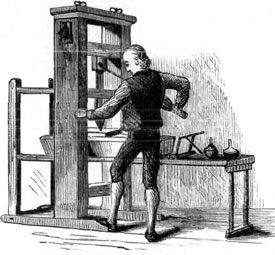An original print is a work of art created by hand and printed by hand, either by the artist or by a professional assistant (often called an artisan) from a plate, block, stone, or stencil that has been created for the sole purpose of producing multiple copies of the desired image.

Each piece produced is not a copy but considered an original, since it is not a reproduction of another work of art and is technically (more correctly) known as an ‘impression’. Any method of printing is not chosen only for its efficiency in producing multiple impressions, but rather for the unique qualities apparent in the different print processes.
The exception to the above statement would be Photomechanical prints, which are considered reproductions. Photomechanical prints are created from a photograph of the artwork, and include line blocks, half tones, photogravures, photolithographs, collotypes and typogravures.
There are four basic types of printmaking:
Relief Printing (raised surface): Woodcut, Wood engraving, Letterpress, Linocuts (linoleum prints).
The background is cut or etched away from the design which leaves the design higher than the background. Relief prints are pressed down on to the paper, the ink lays below the surface of the paper, and the impression may sometimes be seen from the back of the paper. A ‘stamp’ is a simple version of relief method printing.
Intaglio Printing (incised surface): Engraving (metal), Drypoint, Mezzotint, Etching, Photo-Etching, Aquatint, Collagraph, Gravure and Offset Lithograph.
The design is cut or etched away from the original surface which leaves the design lower than the background. The ink fills the incisions when the paper is pressed against the plate. The ink sits on top of the paper surface which can usually be seen in a raking light. An intaglio print may also show the impression of the outer edge of the printing plate, called a ‘platemark’.
Lithography Printing – Planographic Method (flat surface): Lithograph, Chromolithograph.
A wax-resist method where the design is drawn or placed directly on to a flat stone surface with a wax material. The stone is moistened and a greasy ink is rolled over the surface. The ink is attracted to the wax illustration and repelled by the bare wet stone. The stone and the paper are pressed together to create a print. A chromolithograph is a lithograph printed with color, and requires an individual impression for every color.
Serigraphic Method (stencil): Screen Print, Silkscreen, Pochoir.
A blocking technique in which a template is created and adhered to a mesh screen, and the ink is forced through the open mesh areas with a sharp-edged tool (like a squeegee). The template acts as a block. Multicolor serigraphs require several different screens, each with a different template.
Within these four basic methods, there are hundreds of variations, including combinations of two or more different processes. For extensive descriptions of printmaking methods, may I recommend the following excellent resource websites:
Printing Methods in Art
I have spent years exploring the world of antique and vintage prints, each holds fascination for me. At first, they all look the same – a pretty picture in a book. But taking a closer look (literally) you’ll find that it may have been created using one of a hundred different printing methods, from wood engravings to letterpress printing or a photogravure.
Learning how to identify the printmaking process is part of the fun. A magnifying glass, a jeweler’s loupe, and a good reference book can keep me occupied for hours. If you’re like me and prefer a book to hold in your hand, I highly recommend keeping Bamber Gascoigne’s “How To Identify Prints” (link to Amazon page) within arm’s reach. It’s a favorite among antique print collectors and has an excellent section at the back describing how to identify a print using visual clues, which the author calls the Sherlock Holmes Approach, using cross-referencing and a process of elimination to identify printmaking methods.
